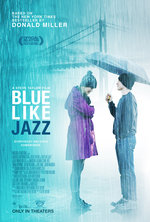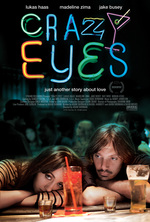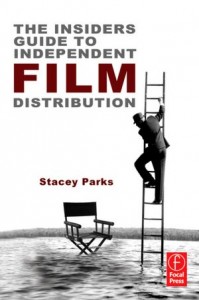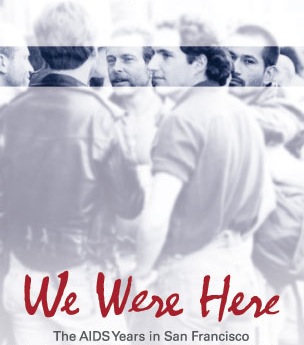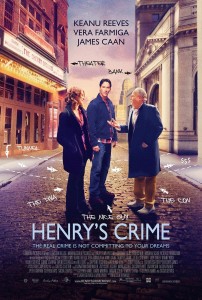
Rethinking Your Key Art Game Plan, Part 2
Guest blogger is The Film Collaborative’s Creative Director, David Averbach, who has worked with dozens of TFC Clients and other filmmakers to help them create and refine their key art. See Part I HERE
Note: This Key Art series is intended for micro-budget filmmakers whose crew is not under a union contract. If your film’s crew is under an IATSE contract, you will need to abide by the rules regarding still photographers on set as forth by the union. We have been advised that there may be penalties involved by bringing an intern or PA in to shoot stills.
Last week, in Part 1 of this blog series, I discussed how relying solely on 1920×1080 pixel frame grabs was a bad idea if one wanted to create a poster that featured some sort of main image. In an ideal world, your entire film would be shot on a 5K camera, and you could pull as many frames from the footage as you wanted. That would be Plan A. But in the real world, many filmmakers emerge from their shoots with only 1080p frame grabs, and that’s not going to work.
Another problem is about marketing. During the chaos of a film shoot, filmmakers often forget to think about the art they might need to support a variety of possible marketing ideas and concepts, and are therefore left with fewer choices and placed in an ultimately weaker position vis à vis possible options on how to market their film without an expensive and inconvenient reshoot.
This blog series offers some concrete advice on how you can protect your film’s marketing future by adding a few inexpensive steps to your key art game plan.
A photographer on the set with a second 5K camera is great if you can afford it. That would be Plan B. But if your budget is limited (or even if it isn’t), last week I suggested a third plan—a “Plan C”—that as far as I’m concerned should be executed whether your film is entirely being shot on a 5K camera or whether there is a professional photographer on set or not. I’m sure I made some of you cringe by suggesting that you pick up a cheap but powerful point-and-shoot camera and putting an intern or production assistant in charge of shooting “hi-res scraps”—basically a lot of shots of the characters in various poses during the down time on a film shoot—that can be utilized down the line by a designer to execute the envisioned poster. The bottom line is this: as a designer myself, I’d rather have the opportunity to work with shots taken from a cheap but decent camera than nothing at all.
One of the reasons I suggested this is that while professional photographers undoubtedly bring a great deal of talent to a set, their exact skill set may not be entirely conducive to producing key art elements. A photographer’s eye for composition usually relies on what they see in bounds of their view-finder, and having them do some of the things that I’m going suggest here in Part 2 of this key art blog series may cause a bit of pushback and confusion. It’s best to let them do what they usually do and concurrently (i.e. Plan C) have a go with the point-and-shoot/intern thing. Of course you don’t have to use a point-and-shoot camera if you have a better one available. But I work with a lot of filmmakers whom I feel would find an excuse not to do this if there were more work/more cost involved. And if you use an intern or a production assistant, or perhaps a rotate through a handful of them, you’re giving them something real to do, which will inspire them to do a better job in everything they are their to do for you. It’s a win-win. Have them take as many photos as they can. Just make sure you buy some extra high capacity compact flash cards.
Now onto Part 2…
You may have an idea of what you want your poster to look like even before you begin your film shoot. Great. But don’t plan for that to be the only idea you execute. You should produce the photos necessary to execute MANY ideas. Here are some possible concepts.
Have a discussion about marketing before your shoot and come up with two dozen ideas. They don’t have to be all that specific. If your film involves one main character, or a pair of characters, then let’s assume for the moment that you could feature them in some way in terms of poster real estate…Accordingly, my first example will be to think a bit about how you could execute a concept that features a single image that takes up the entire poster. Again, you decide what that single image should be…perhaps it’s your main character. Perhaps it’s two characters. Perhaps it’s something else. But here’s the takeaway: at this stage, don’t produce a shot. Produce ELEMENTS.
Let’s have a look at a few posters from current movies that involve a single shot. If these movies aren’t your taste, it doesn’t really matter…the concepts can be applied to almost anything or any style of poster.
 |
 |
 |
Looking at these posters closely in as full a resolution as I could find online, they have one thing in common: each image of the actor is a cutout placed in front of a different background from which the shot was taken. Artbitrage is the most blown-up…if you walk up to this poster in a theater and had a close look, I suspect, you’d see quite a bit of distortion. In The Hobbit, they’ve added a bit of noise to mask the upresing and blend it in with the colors of the bucolic background scene, but I suspect the picture was a much higher res to begin with. Gatsby remains the clearest photo, and the crispness works well with the art deco concept. A designer could create any of these looks with a photo of like the one of Leo DiCaprio, but it would be hard to create a Gatsby-like effect with the photo of Richard Gere.
In the absence of a large format camera in a studio environment, to get as full a resolution as possible, here’s what I suggest, and I know this is a bit unorthodox, but it’s pretty straightforward. Set up a white sheet as a background, or if your subject has a lot of fly-away hair, you may want to try it with a green or blue screen. (I found a cheap one here.) This will allow the designer to take away the background to produce a cutout. This is really no big deal for a graphic designer, unless there is a ton of hair involved, in which case, be sure to try it with a number of different backgrounds. This isn’t a shampoo ad, so shaving off a little hair is forgivable in this arena.
First, take a normal full body shot in portrait orientation just so there is at least one shot of the entire scene you are trying to capture.
But this shot will not be the one that is used. Instead, break the photo up into several shots…the trick is not to hold the camera in portrait orientation but keep it in landscape while you do this…then later on your designer reassemble them into a unified whole.
Why do it this way? Last week, I showed you what you can expect to achieve with a 16.1 megapixel camera:
![]()
Doing it this way will give you the most resolution to work with…
You may need to do it a few times to insure consistency in terms of lighting etc., but with the magic of photoshop, this shouldn’t be much of an issue. You’d want to be careful not to break the shot in the middle of any complicated parts, such as the person’s eyes or mouth, for example.
Start with the person’s face…make sure not to cut off the top of the head (even though two of heads in the posters here are cropped)…
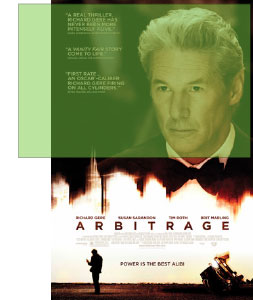 |
 |
 |
Then quickly lower the camera vertically and take another shot, so that the second overlaps just a bit, to get the upper part of the torso.
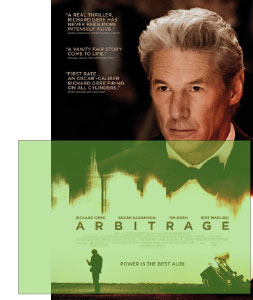 |
 |
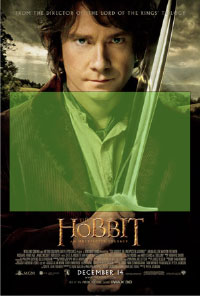 |
Make sure to take dozens of shots like these, so that you have enough photographs to mix and match, as sometimes the pictures can vary in terms of lighting, or your hand is not in the exact position, etc. If there is a prop involved, I would not have that in the shot, but just have them grip something similar and photoshop the item (like a sword) back in later. (Remember to also take pictures of the prop using this technique.)
Perhaps you don’t want to feature just one character…after all, your film may not involve such a recognizable star as Richard or Leonardo. Let’s say you really want a particular shot of two of your main characters in some sort of pose. Like in the following film, Not Fade Away.
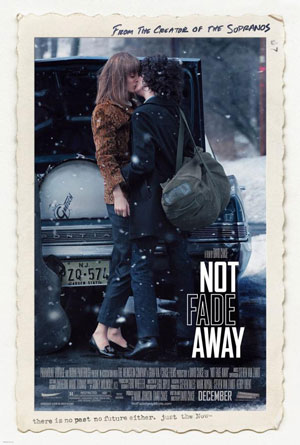 |
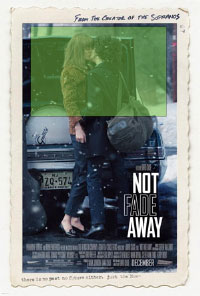 |
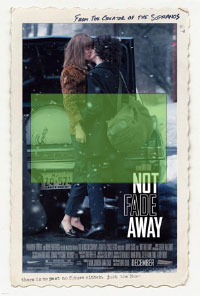 |
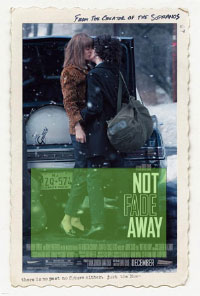 |
It is a bit counter-intuiative, but what I would do here is photograph the two characters in front of a solid background, not in front of the car. Then take a background photo (using the same technique here) of the car without the people. Then have your designer photoshop them together later. I would even go a step further and take a picture of the car without its background, and then take the trees as a separate photo. You never know how the composition will work best with your title treatment, or in different orientations (have a look at key art that is modified for a landscape orientation in iTunes trailer art…you’ll want to be able to move things around to create the look you want in the space that is allotted).
The point is that you are producing elements, not photos. Therefore, don’t just do this type of work for your actors/characters. Do it for your locations as well. You never know what background you may want to use, and the more shots you take, the more options you will have.
Of course, all this requires thinking ahead. But you will be glad you did.
Found this post informative? Check out David’s advice on Developing Key Art as your film enters the festival circuit.
David Averbach December 21st, 2012
Tags: film marketing, film posters, graphic design, key art, Photoshop, set photography, The Film Collaborative, unit publicist
SXSW Wrap up
By Bryan Glick
Just because you didn’t premiere at Sundance or Cannes doesn’t mean you’re out of luck. Though not living up to the sales quota of last year, there are two dozen premiere films from SXSW that have sold in the U.S. Here’s a wrap up of the film sales from SXSW.
Anchor Bay stuck with their niche and took North American rights to two midnight entries Girls Against Boys and The Aggression Scale, while Cinedigm (who recently acquired New Video) went for U.S. Rights to In Our Nature and the midnight audience award winner Citadel. Pre-fest buys include Crazy Eyes which went to Strand Releasing for the U.S. and Blue Like Jazz courtesy of Roadside Attractions. Blue Like Jazz was promptly released and has since grossed close to $600,000 theatrically in North America. Lionsgate is handling DVD, VOD, and TV through their output deal. Meanwhile Crazy Eyes just started its theatrical run on two screens pulling in a little under $5,000 in its first week.
Millennium Entertainment took the gross out comedy The Babymakers and yet another midnight film, The Tall Man was bought for the U.S. by Imagine. If you’re a midnight film at SXSW, odds are things are looking up for you. The same could be said for The Narrative Spotlight section where two thirds of the films have since been acquired including The Do-Deca Pentathlon taken by Red Flag Releasing and Fox Searchlight. Red Flag is handling the theatrical (The film grossed $10,000 in its opening weekend off of 8 screens) while Fox Searchlight will cover the other ancillary markets. The Narrative Spotlight Audience Award Winner, Fat Kid Rules the World was bought by Arc Entertainment for North America and Frankie Go Boom was the first film to reap the benefits of a partnership with Variance and Gravitas. It will be released in the U.S. on VOD Platforms in September via Gravitas followed by a theatrical in October courtesy of Variance.
And though they did not premiere at SXSW, both Dreams of a Life and Electrick Children had their U.S. premieres at the festival and have since been bought. U.S. rights to the documentary Dreams of a Life were acquired by Strand Releasing. Meanwhile, Electrick Children was snatched up for North America by Phase 4. Phase 4 also nabbed North American rights to See Girl Run.
Sony Pictures and Scott Rudin took remake rights to the crowd pleasing Brooklyn Castle while HBO acquired domestic TV rights to the doc The Central Park Effect. Meanwhile, after showing their festival prowess with their success of last year’s breakout Weekend (which was sold by The Film Collaborative’s Co President, Orly Ravid), Sundance Selects proved they were not to be outdone and got the jury prize award winner Gimme The Loot for North and Latin America. Fellow Narrative competition entry Gayby sold its U.S. rights to Wolfe Releasing, a low 6-figure deal. That deal was also negotiated by TFC’s Orly Ravid. And not to be outdone, competition entry, Starlet rounds out the Narrative Competition films to sell. It was acquired for North America by Music Box Films.
S2BN Films’ Big Easy Express became the first feature film to launch globally on iTunes. It will be released in a DVD/Blu-Ray Combo pack on July 24th by Alliance Entertainment followed by a more traditional VOD/Theatrical rollout later this year.
Other key deals include Oscilloscope Laboratories acquiring North American Rights to Tchoupitoulas, Snag Films going for the US Rights of Decoding Deepak, Image Entertainment’s One Vision Entertainment Label aiming for a touchdown with the North American rights to The Last Fall and Factory 25 partnering with Oscilloscope Labs for worldwide rights to Pavilion.
Final Thoughts: Thus far less than one third of the films to premiere at SXSW have been acquired for some form of domestic distribution. While that may seem bleak, it is a far better track record than from most festivals. In The U.S., SXSW is really second to only Sundance in getting your film out to the general public. The festival also takes a lot of music themed films and more experimental projects with each theme getting its own designated programming section at the festival. Those films were naturally far less likely to sell. The power players this year were certainly Anchor Bay and Cinedigm each taking multiple films that garnered press and/or have significant star power. Other companies with a strong presence and also securing multiple deals were Strand Releasing and Oscilloscope. Notably absent though is Mark Cuban’s own Magnolia Pictures and IFC (Though their sister division Sundance Selects made a prime acquisition). Magnolia did screen Marley at the festival, but the title was acquired out of Berlin, and IFC bought Sleepwalk With Me at its Sundance premiere.
While it is great that these films will be released, it also worth mentioning what is clearly missing from this post. There is almost no mention of how much these films were acquired for. The fact is films at SXSW don’t sell for what films at Sundance do and it is safe to assume that the majority of these deals were less than six figures with almost nothing or nothing at all getting a seven figure deal.
As for the sales agents, Ben Weiss of Paradigm and Josh Braun of Submarine were working overtime, with each negotiating multiple deals.
SUNDANCE UPDATE: Since the last Sundance post, there have been two more films acquired for distribution. Both films premiered in the World Documentary Competition. The Ambassador negotiated successfully with Drafthouse Films who acquired U.S. rights for the film which will premiere on VOD August 4th followed by a small theatrical starting August 29th. Also finding a home was A Law in These Parts which won the jury prize at this year’s festival. Cinema Guild will be releasing the film in theaters in the U.S. starting on November 14th. 75% of the films in the World Documentary Competition now have some form of distribution in the US.
A full list of SXSW Sales deals from SXSW is listed below. Box office grosses and release dates are current as of July 12th.
| Film | COMPANY | TERRITORIES | SALES COMPANY | Box Office/ |
| Release | ||||
| See Girl Run | Phase 4 | North America | Katharyn Howe and Visit Films | |
| Starlet | Music Box Films | North America | Submarine | |
| The Babymakers | Millenium | US | John Sloss and Kavanaugh-Jones | Theatrical Aug 3rd |
| DVD Sept 10th | ||||
| Citadel | Cinedigm | US | XYZ Films and | |
| UTA Independent Film Group. | ||||
| The Aggression Scale | Anchor Bay | North America Blu-ray/dvd | Epic Pictures Group | |
| Girls Against Boys | Anchor Bay | North America | Paradigm | |
| Tchoupitoulas | Oscilloscope | North America | George Rush | |
| Gimme The Loot | Sundance Selects | North and Latin America | Submarine Entertainment | |
| The Tall Man | Image Entertainment | US | CAA and Loeb & Loeb | August 31st |
| Elektrick Children | Phase 4 | North America | Katharyn Howe and Paradigm | |
| Blue Like Jazz | Roadside | US | The Panda Fund | $595,018 |
| Crazy Eyes | Strand | US | Irwin Rappaport | $4,305 |
| In Our Nature | Cinedigm | US Rights | Preferred Content | |
| Brooklyn Castle | Sony Pictures | Remake Rights | Cinetic Media | |
| Scott Rudin | ||||
| The Central Park Effect | HBO | US TV | Submarine Entertainment | |
| Gayby | Wolfe | US | The Film Collaborative | |
| The Do Decca Pentathlon | Fox Searchlight | North America | Submarine Entertainment | $10,000 |
| Red Flag Releasing | ||||
| Fat Kids Rules The World | Arc Entertainment | North America | Paradigm | |
| Decoding Deepak | Snag Films | US | N/A | October |
| Big Easy Express | Alliance Entertainmnet | Worldwide DVD/VOD | Paradigm and S2BN | July 24th DVD/Blu-Ray |
| Big Easy Express | S2bn | Worldwide Itunes | Paradigm and S2BN | Available Now |
| The Last Fall | Image Entertainment | North America | N/A | |
| Pavillion | Factory 25 | Worldwide | N/A | Jan |
| Oscilloscope Labs | ||||
| Frankie Go Boom | Gravitas | US Rights | Reder & Feig and Elsa Ramo | VOD Sept |
| Variance | Theatrical Oct | |||
| Dreams of a Life | Strand releasing | US Rights | eone films international | Aug 3rd |
Orly Ravid July 18th, 2012
Posted In: Distribution, Film Festivals, Theatrical
Tags: A Law in These Parts, Alliance Entertainment, Anchor Bay, Arc Entertainment, Ben Weiss, Big Easy Express, Blue Like Jazz, Brooklyn Castle, Bryan Glick, Cannes, Cinedigm, Cinema Guild, Citadel, Crazy Eyes, Decoding Deepak, Drafthouse Films, Dreams of a Life, Electrick Children, Factory 25, Fat Kid Rules the World, Fox Searchlight, Frankie Go Boom, Gayby, Gimme The Loot, Girls Against Boys, Gravitas, HBO, Image Entertainment, Imagine, In Our Nature, Josh Braun, Lionsgate, Millenium Entertainment, Music Box Films, Orly Ravid, Oscilloscope, Phase 4, Red Flag Releasing, S2BN Films, Scott Rudin, Snag Films, Sony Pictures, Starlet, Strand Releasing, Submarine, Sundance, SXSW, Tchoupitoulas, The Aggression Scale, The Ambassador, The Babymakers, The Central Park Effect, The Do Deca Pentathlon, The Film Collaborative, The Last Fall, The Tall Man, Variance, VOD, Wolfe Releasing
Introducing TFC’s new fiscal sponsorship program
The Film Collaborative recently started a fiscal sponsorship program to help filmmakers get access to funds they would not be able to obtain without 501c(3) status. The program is now fully up and running, headed by Lynnette Gryseels, former Fiscal Sponsorship Director at Film Arts Foundation in San Francisco. We have been getting lots of questions from interested filmmakers so here are the answers to many of them. There is also a lot of information available on our website.
What is fiscal sponsorship and how does it benefit artists?
Fiscal Sponsorship is used primarily when a non-profit film/video project or event wants to secure funding from private, foundation, government or corporate sources that give only to nonprofit organizations with IRS tax-exempt status. To be considered exempt, an organization must hold a current 501(c)(3) certificate from the IRS.
What are the benefits to the filmmaker that they couldn’t do on their own?
Many funding opportunities are not available without tax exempt 501(c)(3) status
What does TFC look for in projects to grant fiscal representation?
Projects must be consistent with the Film Collaborative’s charitable purposes. This means that any project you are proposing must be noncommercial and represent an imaginative contribution to the film or video art form. Project can NOT be a “work for hire.” Once that criteria is met, we look for projects that are well thought out and have a good chance of getting funding and being completed. Prior filmmaking experience is helpful or if you are new, it helps to have a production team of experienced people; an advisory board with experience mentors is helpful as well and will help make up for a lack of experience with new filmmakers. A polished proposal is essential. Send us your best effort following the directions and if your project looks promising, we will help guide you to develop your proposal further.
If I apply, am I guaranteed to get accepted?
No. The Film Collaborative is not obliged to supply fiscal sponsorship. We will sponsor projects that are in alignment with the TFC mission and have strong, fundable applications. When we agree to become your fiscal sponsor, we are allowing you to use the TFC name to show support for your film. Therefore, we will only approve a project when the proposal is ready to be submitted to funders.
Is it only for US citizens or those operating within the US?
You do not need to live in the United States or be a citizen to apply for fiscal sponsorship. As long as one of your project’s named project directors has Social Security Number (SSN), Employer Identification Number (EIN), Independent Taxpayer Identification Number (ITIN) or other type of IRS registration. See the IRS for more information on obtaining the correct tax registration for non-residents.
Does one have to be a member of TFC to apply?
Yes. Applicants need to be a TFC member at the minimum Contributor level. See http://www.thefilmcollaborative.org/join.html to sign up.
How does one qualify?
To qualify, you must have
-A film project; documentary, narrative or short in any stage of production;
-You must join the Film Collaborative at the Contributor level or higher;
-Your project must be consistent with the Film Collaborative charitable purposes, is noncommercial and/or educational and represents an imaginative contribution to the film or video art form;
-The project may not be “work for hire”;
-You must be seeking donations in the form of grants from public agencies, foundations, corporations, or individual donors including fundraising benefits.
What is the submission process?
1. Join The Film Collaborative;
2. Pay the $35 fiscal sponsorship application fee;
3. Fill out and submit the online application form, and upload a PDF of your project proposal.
The application you submit to the Film Collaborative will also serve as a blueprint that you will use to secure funding by applying for grants or present to prospective contributors. Our goal is to help you build the best possible proposal in order to go forward and successfully raise the necessary funds to realize your project. Therefore, we accept projects with proposals that are ready to go.
What is the submission deadline?
There are no submission deadlines. Applications are open.
After I receive backing from TFC, what happens?
Once accepted, we will send you a copy of the Fiscal Sponsorship contract, a W9 form, a welcome package which includes a fiscal sponsorship support letter, tax ID number, a copy of your signed contract and information on how to set up online donations. Donors to your project can contribute online using a credit card or write checks to the Film Collaborative. Donations will be disbursed at the end of each month.
Once your project is accepted you can now apply for funds from public agencies, foundations, corporations, or individual donors. TFC will provide you with the necessary documentation to show that your project is fiscally sponsored.
Can I apply to the NEA, NEH, NSF or other government agencies?
The Film Collaborative cannot submit applications on filmmakers’ behalf to the National Endowment for the Arts (NEA), National Endowment for the Humanities (NEH) and National Science Foundation (NSF). Ask us about all other government agencies.
What are the administrative fees involved and what do they pay for?
Applicants must join the TFC and pay a $35 non-refundable application fee. After that TFC takes 5% of funds donated to your project. These fees pay for overhead such as staff time processing applications and donations.
Is there a reporting process?
Yes. You must report to TFC twice a year on all funds received for your project, monies spent and any significant budget changes. Failure to comply with the reporting process will result in project termination.
Does TFC provide advice on contacting donors and soliciting funding?
We can provide some advice and answer questions. You are responsible for applying for your own funds and sourcing your own donors.
Is there a difference between this service and others like Fractured Atlas?
Yes. TFC only sponsors film projects, Fractured Atlas sponsors many other types of projects in addition to film. The 5% TFC fee is the lowest of any known film project fiscal sponsor.
How long does the fiscal sponsorship stay active?
Your fiscal sponsorship will remain active as long as your reports to the TFC are up to date and you are still working on your film. Projects that fall behind on reports will be terminated and will require a fee to reinstate. Any funds donated to a dormant or terminated project cannot be dispersed until the project reporting is brought up to date.
Is the TFC fiscal sponsorship program exclusive?
Yes and no. Your project can have another fiscal sponsor that is not a film project fiscal sponsor, for example, a community organization or something related to your project is fine.
Can name changes or change of control happen under the sponsorship?
Yes, on a case by case basis, depending on the change required. Please ask.
Can I change my project or have more than one project entered into the program?
Depending on the nature of the change it may be considered a new project. Multiple projects by one filmmaker are possible.
What is your background with fiscal sponsorship/grant funding applications?
The TFC fiscal sponsorship program is headed by the former director of fiscal sponsorship at the Film Arts Foundation in San Francisco. We are used to reviewing proposals, have relationships with funders and can advise you on creating an attractive funding application.
Lynnette is passionate about film and helping filmmakers tell thought-provoking stories that entertain, assist social change and support their filmmaking aspirations. She has over 15 years experience working with independent filmmakers, non-profit film organizations and several local and international film festivals. She has previously assisted filmmakers in learning their craft through educational program development and project development support. At Film Arts Foundation in San Francisco Lynnette headed the Fiscal Sponsorship and Grants Program, one of the oldest fiscal sponsorship programs in the country. She brings a depth of knowledge from this experience to her role as head of TFC’s fiscal sponsorship program.
Orly Ravid July 3rd, 2012
Posted In: fiscal sponsorship
Tags: 501c3, charitable contribution, documentary, donors, financial reporting, fiscal sponsorship, Fractured Atlas, grants, independent film, Lynnette Gryseels, non profit, noncommercial, private funding, tax exempt, The Film Collaborative
Lead up to Cannes: Digital Distribution Beyond the Old World
This post was originally published on the Sundance Artists Services blog on April 23, 2012. This is an interview between Rights Stuff’s Wendy Bernfeld and The Film Collaborative’s Orly Ravid on the state of digital in Europe
In the past, many new media and VOD platforms – whether based on pay-per-transaction (TVOD), subscription (SVOD), free to user/ad supported (ADVOD) or download to own (DTO) — came and went, to the disillusionment of those brave souls trying to explore and develop the new sector and audiences.
Some filmmakers, sales agents, distributors who dared to license were wonderfully pleased with surprisingly good results for particular films (and not always the same ones that were mainstream successes in traditional media), but on balance, let’s face it, most were underwhelmed with the lackluster performance or transience of the various sites, and eventually became jaded about the whole sector. But it’s no longer a viable option just to sit back.
Over the past 18 months particularly the digital/VOD sector (including internationally) has finally begun paying off well for filmmakers, producers, distributors, and sales agents… at least for those who are willing to take the time to navigate (alone or partnered with others) the complexities of the sector, play with creative ”windowing’’ while balancing opportunities from traditional media, and accept initially more modest revenues from multiple smaller deals across various platforms and regions (yielding cumulative revenues in a largely non exclusive sector).
In addition to traditional media deals and VOD deal potential with IPTV, telecom, and cable offerings, and larger American sites (e.g. Hulu, YouTube, Netflix, iTunes), your film may well find interested audiences and homes on EU/international platforms…even if not picked up in the USA.
HOW IS INTERNATIONAL DIGITAL DIFFERENT FROM THAT IN THE USA?
The EU (beyond UK) deals with multiple languages, different tastes and appetites, different windows (vs consistent release patterns/dates per country), different platforms to navigate and balance against multiple different traditional media buyers, and, to be honest in general more work for smaller potential revenues from each deal/window.
But on the plus side, films can find homes overseas in many markets and windows, even if not ending up in the mainstream or major US/UK platforms.
The UK is at the moment probably the more stable and lucrative for English (the VOD market is already very competitive, with large platforms like Netflix, Lovefilm, BSkyB, FilmFlex, iTunes, and Blinkbox) but as soon as you ripple out to EU, digital distribution will take more work and art and generate relatively less money, especially if your film is only in original English language, and not already exposed in terms of promo/PR (theatrical, DVD release in the region etc.). However, there is indeed a growing appetite by now for art house, festival, docs, quality indie films, and foreign language films, if well curated, e.g. around festivals/brands/themes rather than as one-offs.
WHO’S OUT THERE in EU and what are some of the key territories where digital is meaningful?
Digital is immediately more meaningful in the UK, France, the Nordic region, and in Benelux, where there are already pc/mobile and tech-savvy customers and a willingness to view films in English with subtitles (vs. the dubbed regions of Germany, Spain, Italy etc., where one has to invest more to get the languages to cross over).
Although publications often refer to figures noting several hundreds of VOD platforms in Europe, in my view there are only probably 100 or so that are worth talking about when discussing licensing—half of which the main revenue generators, and another half of which are still potentially significant buyers(depending on the film of course)
In Europe, as in America, transactional VOD (pay per view) platforms are more established – some regional (per country), and others multi region (e.g. Acetrax, UPC/Chello, Headweb, iTunes, Playstation Network Live, Voddler, Xbox Live). Outside of the UK, one obviously enhances possibilities if addressing customers in their own languages and tailoring content to local preferences such film classification, advertising, and general consumer and cultural tastes.
iTunes has only recently (in autumn 2011) begun to expand its footprint into Europe, including in the following EU countries: Austria, Bulgaria, Cyprus, Czech Republic, Denmark, Estonia, Finland, Greece, Hungary, Latvia, Lithuania, Malta, Netherlands, Norway, Poland, Republic of Ireland, Romania, Slovakia, Slovenia, Spain, Sweden, and the United Kingdom. Non-English stores include: Spain, France, Germany, Italy, Luxembourg, Belgium, Switzerland, and Portugal. They also just recently launched in Brazil / Latin America as well.
NETFLIX, Amazon (via Lovefilm), and Hulu are expanding their international footprint too. Netflix, for example, recently launched in UK/Eire, and is anticipated to roll into other regions such as Spain thereafter, and has already extended its occasionally original production commissioning activities to EU (e.g. Denmark – Lillyhammer deal, and more recently France (Gaumont etc) – Hemlock Grove series funding ). Lovefilm already has a presence beyond the UK (in Germany and Nordic), and is anticipated to expand regions. Hulu has not yet launched in EU but did launch already in Japan. As part of its competition rampup (in the US against Netflix in the SVOD market, it has also began commissioning original programming, (Day in the Life – Morgan Spurlock, for example, which was just picked up by Fremantle for distribution thereafter)….and also continues seeking special films or shows to do stunts around. We understand that they are trying to acquire more Spanish rights for the US…an important strategic move for other US players trying to expand their footprint in EU as well. Meanwhile in early 2012 the UK became a hotbed of activity for SVOD, with deals that would formerly have been nonexclusive (with e.g. Netflix, Lovefilm) being now struck on a lucrative exclusive basis, following the example of the competitive SVOD vs. Pay TV market in the US.
So what are the other key EU platforms? Trends?
Various international platforms are now becoming increasingly interested in licensing more art house, niche and festival films–not just mainstream titles. It is expected that some of the larger brand sites this year (e.g. those in UK like Netflix, Lovefilm, etc.) will expand the indie/art house and festival category further, and also be open to foreign language films (dubbed or subtitled as applicable per country audience as above). Most deals for art house/fest films, where not locally versioned or released in theatres or DVD, are on a non exclusive rev share basis, and in some cases where there is particular acclaim or cast, it can be coupled with a modest upfront, while if on an SVOD basis, flat fee deals apply (similar to non-exclusive Pay TV licensing deal parameters).
But in countries where the Pay TV incumbent is competing against a new web player, such as a traditional Pay TV player “vs.” SVOD (like Netflix “vs.” HBO in the US, or Lovefilm/Amazon “vs.” BSkyB in UK), as above, the fees can be more lucrative, in the form of true flat license fees in the Pay TV range. – whether on exclusive or non exclusive basis, and thus matching or exceeding the normal price ranges before the competition. As well, when competition heats up over one category of title, it’s also not unusual to have the competitors round out, extend, or diversify their consumer offer and move into other genres, to try to distinguish themselves from the competition. This is happening in more and more countries– for example the Netherlands, where HBO /Ziggo just launched in February and the local incumbent, Film1, responded by adding a branded art house/indie thematic channel (Sundance Channel).
Key note: Deals are generally non-exclusive and thus if carefully staggered, one can license the film sequentially through various windows (TVOD, SVOD, AVOD, and if applicable, DTO) and in multiple regions.
An example: one can first license a current film for transactional VOD (TVOD) on a rev share basis to cable and telecom VOD platforms (like France Telecom/Orange, UPC, etc) as well as (simultaneously) web based players (e.g. iTunes), then to subscription -based windows (premium Pay TV (e.g. HBO, Viasat) and their corresponding “TV Everywhere” offerings, thematic Pay TV, and/or standalone SVOD services . Thereafter, the film can move to other ad-supported services (free to consumer, web based, e.g. YouTube AVOD). This pattern can apply in multiple countries.
As mentioned above, there are hundreds of local European platforms —both standalone web-based services and mainstream and/or local telecom and Cable VOD platforms that have online offerings of their own. VIASAT, for example, was historically a premium pay service, but now offers not only conventional Pay TV and ”TV Everywhere” but also standalone thematic offerings to non-subscribers (SVOD to PC). Similarly, BSkyB just announced the upcoming launch of NOW TV – also aimed at non- subscribers (“Cord Nevers, and/or Cord Cutters”) – a thematic SVOD/low pay offering of films.
Opportunities will only increase in 2012 and 2013 as more from USA players, sites, and OTT box offerings beyond Netflix, Hulu, and Amazon gradually cross over to EU/international markets particularly if the new services don’t limit themselves to mainstream offerings and tastes.
Getting to the platform: As in the United States, some of the larger platforms (such as LOVEFILM, BlinkBox, Netflix, itunes) only take larger packages of films with a minimum volume, and are unwilling to deal direct with producers and distributors for “one off” deals. Until recently, most of the larger sites also focused mainly on mainstream films. In general, these services steer filmmakers towards conventional distributors, or aggregators/digital distributors like Movie Partnership (UK); but sometimes will accept dealings direct for certain films, or will go via an agent working on a flat fee basis (like Rights Stuff / Film Collaborative). In the latter scenario, the film IP remains in the filmmaker’s/distributor’s name, the money from deals flows to them directly and they get access and paid advice through third party consultants/agents/advisors.
Up until now, having had a DVD and/or local theatrical release was quite important for enhancing deals. But increasingly now online sites are willing to handle more innovative windows, e.g. premiering films online, or Day & Date with other windows (or shortly thereafter). Lesser-known or library (catalog) films can usually find a home on a non- exclusive and on ad-supported (AVOD) basis, but more current films usually start with transactional (TVOD) basis and/or subscription platforms (SVOD)… If filmmakers have titles already encoded to the expensive iTunes spec, this can be helpful in wider distribution, but it’s not essential; many digital platforms are now willing to take delivery of indie or art house films even via DVD or a hard drive/ digital master.
In terms of deal models, some aggregators (middlemen) take larger %s but then take care of all encoding and delivery fulfillment, while others who are more in an advisory or agent role take a lower share for deal making and platform access but leave you to arrange the encoding separately. In some countries (e.g. Brazil), platforms may not take English versions unless local subtitles or dubs are available, and work with distributors who create versions where necessary. These distributors co-curate packages with filmmakers based on experience of what “moves” best in the region so as not to invest in encoding or language versioning for films that may not generate enough revenue to justify it…
A side note regarding subtitling, by the way: Film Collaborative is looking into software that helps facilitate dubbing in the same voice as the actor/speaker, but meanwhile in any case, subtitling for digital is getting less and less expensive and can be done via relatively inexpensive software or labs. If one has shown a film at a film festival in another country and plans to then distribute the film there, we’d recommend you ask the fest for access to the subtitles (if cleared for other distribution). Traditionally, Nordic, Benelux, and some other regions are fine with and prefer subtitles, while others (such as Germany, Spain, and Italy) require dubbing. However, in the higher-educated arthouse/filmfest world, one can often get away with just subtitled versions even in the dubbing countries.
As indicated above, for better platform access, one may want to pick or join with new media /digital distribution specialists – particularly if your traditional sales agent or distributor, strong in conventional media (theatrical, video etc.) is however not active or savvy in the VOD landscape above (platforms, deal terms, contacts etc). Otherwise it can be a self-fulfilling prophecy that you then ”don’t make money in digital’’. It’s a balancing act of cost vs. services, and a lot of work in international!
And filmmakers, whatever you choose to do with respect to your digital distribution, do not forget that one can also reach the whole wide world via one’s own website(s) and social networking pages by utilizing DIY digital distribution services (for more on this topic please refer to numerous past blog posts about digital distribution and DIY platforms and services at www.TheFilmCollaborative.org/blog and/or the Resource Place at www.TheFilmCollaborative.org/ResourcePlace).
As for piracy: in various cases filmmakers can tap into or derive indirect benefit from these online communities. See for e.g. Sheri Candler’s case studies in www.SellingYourFilm.com, Some filmmakers partner with Bit Torrent, Pirate Bay etc to launch their films online, tapping into the audiences already there (e.g. Nasty Old People, The Tunnel, Yes Men Fix the World).
LET’S TALK ABOUT POTENTIAL FUTURE TRENDS:
Diversification, Cross Platform/Transmedia: We believe 2012 will see continued consolidation of platforms and fuller diversification within the genres offered. Also as above, some key platforms (such as Hulu, Netflix, Yahoo, Endemol/AOL, Nokia, Canal+, Orange, ARTE, Channel4, ) are now also selectively commissioning transmedia and/or branded film opportunities (YouTube has not begun funding outside US yet). New funds and educational bodies (including MEDIA, Power to the Pixel) are increasing the emphasis on digital as a 360 proposition from inception of the film production process.
Multi-Layered Business Models: Platforms’ business models are also starting to become more multi-layered to handle different genres, consumer price points, and windows. For example, AVOD platforms such as YOUTUBE and SVOD platforms such as Lovefilm are now adding premium transactional VOD (TVOD) in order to handle current films. And as above, SVOD players are expanding their offerings beyond just library titles, beginning to buy newer and newer films in order to compete against premium PAY TV. This trend is continuing in the newer launching countries, e.g. Holland and Brazil where new PAY TV and localized SVOD and AVOD entrants have launched (e.g. YouTube regional sites). YouTube is also commissioning Made for Web content (MFW), although first in English language countries.
Festivals: Some European festivals have also recently started offering select titles on a TVOD basis. Rights Stuff recently worked with IDFA.tv to put around 100 films online—some on an AVOD basis and some on a TVOD basis—and in future more will follow. Certain other festivals (such as IFFR) have also begun to follow the US festival path of offering limited TVOD around or during the festival. This can open many doors for filmmakers, but also requires careful juggling and balancing when figuring out distribution patterns for conventional vs. online and new media….the balancing act is always key.
Traditional Players add VOD as well: As to the more traditional PAY TV players, last year after EPIX began licensing international festival documentaries it then turned its focus more to co-productions instead of acquisitions. And over 2011/12,As in the US, many traditional PAY TV platforms are going cross-platform and on multiple devices (a la “TV EVERYWHERE”, and similarly the nonlinear online channels are often seeking multiple device rights and/or at least have an App). Thus balancing traditional PAY TV sale vs. digital media requires more attention in rights grants and windows, but offers more opportunity correspondingly. In terms of trends, it still seems like the bigger funds and platforms are still more focused on more mainstream content, however as above this is starting to expand in EU to a wider net of content and genres.
REGIONAL EXAMPLES: VOD LICENSING PLAYERS AND WINDOWS in EU:
For bigger indie titles and mainstream ones, there are usually about 5-8 or so VOD outlets that one can target per country. Most of these will buy TVOD rights and sometimes also SVOD and/or AVOD. Platforms include television-related services (IPTV, Telecom/Cable companies, etc), as well as online and/or mobile sites, OTT box offerings, and consumer electronic (e.g. connected TV) portals.
For e.g. in Holland, a film or TV show can have various TVOD deals, not only with MSO like KPN, Tele2, Ziggo, and UPC, but also with web based services like Cinemalink.nl (for art house), iTunes, and the newly launched service from theatrical distributor Pathé (a Rights Stuff client), pathethuis.nl a bold move by a traditional theatrical exhibitor to also launch and embrace TVOD for a fuller offer to its film-loving audience base.
That would then be then followed by Premium PAY TV and/or SVOD sales (e.g. Film1, Ziggo/HBO, Ximon, Mubi.com), then AVOD (YouTube, IDFA.tv) with various competing players per region. The same film can also attract interest of foreign platforms not yet launched in the region but scaling up behind scenes, poised to launch there (e.g. those seeking to next move after UK into, say, Spain or other Benelux regions/Nordic). And this is on top of the broadcaster based proprietary VOD services (e.g. RTLXL and Veamer (from SBS and public TV catchup sites.
There are also various local equivalents of genre sits like Fandor or IndieFlix in certain EU regions. MUBI (www.Mubi.com) (co-owned by the rights holder to one of the most expansive libraries of art house cinema, Celluloid Dreams) is technically available everywhere, and is sometimes syndicated as an SVOD channel to telecom platforms (as in the case with Belgacom in Belgium). It is also on Sony Playstation. Last we checked, 60% of its audience was the US and most of the rest in Europe. Revenues from it for our films (TFC) have been small to-date, low 3-figures but it’s a good pedigree platform and perhaps revenues will increase.
A few others in EU include e.g. Orange, Canal Plus, (France and, multi region), Telenet, Belgacom, (in Belgium), SF Anytime, Voddler Film2home, Headweb , Viasat etc in Nordic /other regions), Telefonica, … Maxdome (Germany), Sony-related Qriocity, Daily Motion (many countries in EU), Movieeurope, Zattoo. Sales agent Wild Bunch has also recently launched a platform service called FilmoTV.
And as an aside, in Brazil/Latin America, the market has been heating up intensely in late 2011/12, with various TVOD and IPTV platform launches players, as well as competitive new PAY TV and SVOD services (eg Netflix, Netmovies, Terra) springing up or extending VOD. NewPAY TV laws (from fall 2011) are resulting in more potential competition, which is good news for filmmakers seeking new audiences over there. Our recommended approach to filmmakers seeking deals in this region is to partner locally, e.g. with ELO Distribution, with whom we work traditional and non-traditional (new media) players.
These are just a few categorical examples…there are plenty more buyers and platforms emerging internationally, including consumer electronics manufacturers (such as Samsung and tablet and connected TV manufacturers in EU and internationally who are getting into the game either on the licensing front or occasionally even funding/commissioning Transmedia or mfw (Made for Web). However, these usually license fuller sites (like a Lovefilm or Snagfilms) and not individual one –off titles.
Overall, there are a lot of small markets and platforms, and all this takes a lot of work, but if one has built community around a film and awareness then the effort may pay off and add up to a nice revenue stream. Once the first deals are in place with platforms (deal structures, relationships, contacts, contracts) it’s easier to build on that and add new films to the deals with just short amendments or riders, so the effort at the front end makes years of future dealings run smoother.
TRENDS RE: OTHER GENRES:
Aside from art house, festival indie films, and docs, one area that we expect to see more SVOD licensing around is kids’ films. Various smaller sites also have a strong appetite for gay/lesbian, martial arts, and horror programming, graphic novels, and made for web/cross platform/Transmedia original productions…but one has to be selective. As to documentaries, the combination of a large number of doc sites in the EU with the heavy exposure of docs on public and conventional TV in EU means docs can be relatively harder to monetize here, unless well curated and packaged, for e.g. under a larger brand/festival, like IDFA.
WINDOWING:
Typically films follow the sequential windowing described above when moving through the Transactional, Sell Through, Subscription, and ADVOD windows. But for certain films it it can be clever and compelling to have windows intentionally reversed or out of sequence. For example, premiering a film ONLINE or day-and-date with another cross-promoted window ahead of theatrical, and heavily emphasizing social media marketing can allow producers to build (and engage with) the audience before the film is even out. The key is to know your audience and try to tailor the marketing and distribution patterns accordingly…producers can be more active these days to heighten the chances of film success.
More and more platforms are open to this REVERSE WINDOWING (which began successfully in the US, e.g. with Lars von Trier’s Melancholia), . For example, in Holland, the film Claustrophobia launched online first and its success via social networking ultimately brought it a theatrical deal. In another case, Submarine NL’s film ‘’Molotov Alva’’ (a second life documentary released online virally first) later secured a HBO sale on premium pay tv, and in another film we worked with (the documentary Surfing and Sharks), intensive social network/audience engagement before and during the film’s festival exhibitions helped not only to enhance the potential audience for the film ahead of commercial released, but also to attract wider sponsor support. Ultimately, the visible online appetite for the film (including the number of Twitter and Facebook followers amassed in a very short time) helped result in a stronger all-rights distribution deal as well.
There are various new platforms focused on these models that are launching and expanding reach in EU– e.g. EU1 (The Makers Channel), which just launched in the Netherlands and will soon expand to other EU regions. One part of the site is business-to-business (geared towards talent, directors, actors, producers, etc.) providing for online pitches and related crowd sourcing and crowd funding (like Kickstarter). The other component is business to consumer, and allows exhibition of works online, on a rev share VOD basis… which will be coupled for the first time with TVOD exhibitions on UPC/Chello/Ziggo (the Cable TV VOD platform partners) thus giving much wider audience reach than conventional web VOD to PC. In some cases films can also combine a theatrical (conventional or event theatrical local) release for the films “day and date” with or in staggered creative windows. We are working with two English film cases in NL already, and as this site expands to other regions and to wider English crossover, this will open up many more opportunities (in some ways similar to what you see already in the USA on Tribeca/Sundance with exhibitions on cable households (TVOD).
SHOW ME THE MONEY:
Even where indie features have no theatrical or DVD release, if there is some cast and acclaim from festivals, and the film is new/current, TVOD is possible . This is usually on a rev share basis (with %s ranging from 50-50 to 70-30, with various deductions to negotiate). In SVOD/PAY TV, flat fees are normally paid instead of rev share, usually, along lines of comparable non-exclusive PAY TV license fees for indies. For example, in medium sized, non-English language EU countries, we’ve seen SVOD flat fee prices range from 5K-50K per title where it’s been theatrically or DVD released, etc, while with less exposure or more niche, sometimes the flat fees can be lower and more aligned with AVOD. In AVOD, deals are usually rev-share, (50-50 to 70-30) with sometimes a small upfront fee. In a medium-sized EU region, MG’s (Minimum Guarantees), when given at all for indie film, can range from a few hundred dollars (plus rev share) to 1-2K for higher end material. The very largest platforms may get away with no upfront fees at all due to their scale and reach, but smaller EU sites may well, depending on the film, offer something modest. When you do multiple nonexclusive deals, these can add up and help defray some costs of versioning, digitization, deliveries, etc.
As to revenues generated from VOD once the license is done: again it is platform and film specific, and one cannot generalize. We’ve seen certain cases where niche foreign language art house films yielded 40K in 2 months of non-exclusive TVOD revenues across a few platforms, , while other titles from the same distributor yielded only 1-2K in the same deals/time period. Things are similar with SVOD – fees can range in one small non-English EU country from 5k to 40k for a single SVOD window license fee (non exclusive) – so the key is still in our view still to engage in a reasonable number of deals in each country across various windows, platforms and business models.
IN SUM: SOME TIPS FOR GOOD RESULTS IN DIGITAL DISTRIBUTION:
- We strongly advise building audience for the film before release, even while the film is still being made. Engage in social media marketing around the themes of your film and the cast: Twitter, Facebook, YouTube (promos) etc. This not only enhances the audience and reach of your film, when it is released, but potentially your distribution and/or digital deal making as well.
- Once a deal is done and even after the film is sold, it still helps for the producer or distributor to take an active role in social media marketing, e.g. to direct attention (via social media etc.) to scheduled exhibitions of the films on various platforms licensed. Many platforms in EU are still showing viewers EPG’s with clumsy alphabetical “listings’’(as opposed to the type of creative Netflix/Lovefilm recommendation engines and suggestions), so helping viewers find the film will in turn increase returns.
- As for digital deals: We’d also recommend that individual producers who cannot afford tailored individual advice consider combining forces via producer groups to collectively fund some serious upfront advice – help each other curate more attractive packages of their better material, so easier to sell on to platforms directly or indirectly – and grouped in many different ways (theme, genre, category, audience etc.).
- If necessary, try to have “split rights’’ deals. If the person to whom you are entrusting the film in an “all rights” deal is less strong in digital and likely to “sit on” new media rights, you can explore splitting these rights /sharing them non exclusively with the distributor and another specialized digital distributor, case by case. Rights Stuff has often done this working with sales agents and distributors and producers directly to maximize digital distribution.
- Work with festivals (both traditional and online), who can play an increasing role in EU as they cross over to the digital space and VOD offerings. But be careful about the scope and duration of rights granted vs. other traditional and digital media, to maximize potential in all areas.
- Don’t abdicate completely, ie don’t’wash your hands of the film once you put it in someone else’s hands (the conventional sales approach) – keep involved along the way, gain as much learning as possible, split revenues, resources, knowledge base, contacts … and lever the outcomes to your next and future films.
Final notes: Pricing of films on the transactional side is relatively commensurate with that in the US, however non USA SVOD and AVOD markets are smaller with lower revenue per deal. . We did not include VIEWSTER in this article but feel free to check them out. They are a consumer-facing platform that also supplies other platforms (i.e. functions like an aggregator). They seem to favor films with cast, more commercial films and those with a bigger profile. www.Viewster.com
Orly Ravid May 15th, 2012
Posted In: Digital Distribution, Distribution, Distribution Platforms, Hulu, International Sales, iTunes, Netflix
Tags: aggregators, AVOD, digital distribution in Europe, distributor, DTO, independent film, Orly Ravid, release windows, Rights Stuff, sales agent, subtitling, Sundance Artists Services, SVOD, The Film Collaborative, TVOD, Viewster, Wendy Bernfeld
Navigating digital distribution, 11 things to consider
This post by Orly Ravid was published originally on the Sundance Artists Services blog April 15, 2012
1. CARVE OUT DIY DIGITAL:
Distributors and Foreign Sales companies alike often want ALL RIGHTS and including ALL DIGITAL DISTRIBUTION RIGHTS.
No matter what, at least CARVE OUT the ability to do DIY Digital Distribution yourself with services such as: EggUp, Distrify, Dynamo Player, and/or TopSpin, off your own site, off your Facebook page, and also directly to platforms that you can access. Platforms and services can almost always Geo-Filter thereby eliminating conflict with any territories where the film has been sold to a traditional distributor and often times a distributor will not mind that a filmmaker sells directly to his/her fans as well in any case.
2. PLATFORMS ≠ AGGREGATORS ≠ DISTRIBUTORS:
Platforms are places people go to watch or buy films. Aggregators are conduits between filmmakers/distributors and platforms. Aggregators usually focus more on converting files for and supplying metadata to platforms and that’s about it. Marketing is rarely a strong suit or focus for them but it should be for a distributor, otherwise what’s the point? Aggregators usually don’t need rights for a long term and only take limited rights they need to do the job. Distributors usually take more rights for longer terms. Sometimes distributors are DIRECT to PLATFORMS and sometimes they go through AGGREGATORS. It makes a difference because FEES are taken out every time there is a middleman. Filmmakers should want to know the FEE that the PLATFORM is taking (because it’s not always the same for all content providers though usually it is other than for Cable VOD, for example) and know if a distributor is direct with platforms or goes through an aggregator. Also, filmmakers should have an understanding what each middleman is doing to justify the fee. On the aggregator/distributor side, we think 15% is a better fee than 50%, so have an understanding of what services are included in the fee. If a distributor is not devoting any time or money to marketing and simply dumping films onto platforms, then one should be aware of that. Ask for a description in writing of what activities will be performed.
3. THINK OF DIGITAL PLATFORMS AS STORES AND CUSTOMIZE A PLAN THAT IS RIGHT FOR YOUR FILM:
A film should try to be available everywhere however sometimes that is too costly or not possible and when that is the case one should prioritize according to where the film’s audience consumes media. Think of digital platforms as retail stores. Back in the DVD days (which are almost gone), one would want a DVD of an indie film in big US chains such as Blockbuster and Hollywood Video but especially a cool, award winning indie would do well in a 20/20 or Kim’s Video store because those outlets were targeting a core audience. With digital, it’s the same. While many filmmakers want to see their films on Cable VOD, some films just don’t work well there and delivery is expensive. Some films make most of their money via Netflix these days and won’t do a lick of business on Comcast. Other films do well on iTunes and some die there whereas they might actually bring in some business via Hulu or SNAG. Docs are different from narrative and niches vary. Know your film, its audience’s habits and resolve a digital strategy that makes sense. If money or access is an issue, then be strategic in picking your “stores” and make your film available where it’s most likely to perform. It may not be in Walmart’s digital store or Best Buy’s. Above all, if you dear filmmaker have a community around you (followers, a brand), your site(s) and networks may be your best platform stores of all. Though there is something to be said for viewing habits so I do recommend always picking at least a couple other key digital storefronts that are known and trusted by your audience.
4. TIP FOR CABLE VOD LISTINGS:
By now many of you may have heard that it’s hard to get films marketed well on Cable VOD platforms. Often the metadata either isn’t entered or entered incorrectly and it’s nearly impossible to fix after it goes live. Hence, oversee the metatags submitted for your film and check immediately upon release. Also, since genre/category folders and trailer promotion are not always an option for every film, it is the case that films with names starting in early letters of the alphabet (A-G) or numbers can perform better. Then again, there’s a glut of folks trying that now so the cable operators are getting wise to this and not falling for it. All the more reason to focus on marketing, marketing, marketing your title, so audiences are looking for it and not just stumbling upon your film in the VOD menu. There are only going to be more films to choose from in the future, not fewer.
5. ART for SMALL:
Filmmakers, if there is one thing I must impart to you once and for all it’s this: TAKE GOOD PHOTOGRAPHY!!! Take it when making your film. Remember, most marketing imagery if not all for digital distribution (which will be all of “home entertainment”) must work SMALL so create key art and publicity images that also work well small and in concert with the rest of your campaign. Look at your key art as a thumbnail image and make sure it is still clearly identifiable.
6. KNOW YOUR DIGITAL DISTRO GOALS AND PLAN AHEAD:
I have seen distribution plans wasted because a vision for the film’s path was not resolved in time to actualize it properly. If your film is ripe for NGO or corporate sponsorship and you want to try that, you will need loads of lead time (6-12 months at least!) and a clear distribution plan to present to potential sponsors (who will always need to know that before agreeing). If making money is a top concern, then know how YOUR FILM’s release is mostly likely to do that and plan accordingly. It may be by collapsing windows or it may be by expanding them. All films are different and that’s why it’s best to look at case studies of films with similar appeal to yours. And if showing the industry that your film is on iTunes matters to you for professional reasons more than financial then know that is your motivator but know that getting a film onto iTunes does not automatically lead to transactions, marketing does.
7. TIMING IS EVERYTHING | WINDOW WATCHING:
Digital distribution often has to be done in a certain order if accessing Cable VOD is part of your plan. That is not the only reason to consider an order and an order is not always needed, but it can be a consideration. Sometimes Cable VOD is not an option for a film (films often need a strong theatrical run before they can access Cable VOD) and, in this case, the order of digital is more flexible and one can be creative or experiment with timing and different types of digital. However, Cable VOD’s percentage share of digital distribution revenues is still around 70% (it used to be nearer to 80%) so if it’s an option for your film, it’s worth doing, at least for now.
It is very often the case that if your film is in the digital distribution window before Cable VOD (on Netflix for example), that will eliminate or at least dramatically diminish the potential that Cable MSO’s (Multi System Operators) will take the film or even that an intermediate aggregator will accept it. There is more flexibility with transactional EST (electronic sell through) / DTO (download to own) / DTR (download to rent) services such as iTunes but much less flexibility with YouTube (even a rental channel) or subscription or ad-supported services such as Netflix (subscription) or Hulu (which is both). Films that opted to be part of the YouTube/Sundance rental channel initiative (such as Children of Invention) could not get onto Cable VOD after. The Film Collaborative has to hold off on putting films in its YouTube Rental Channel if cable VOD is part of the plan. Of course, there are exceptions to every rule due to relationships or a film proving itself in the marketplace, but better to plan ahead than be disappointed.
Companies such as Gravitas are also programmers for some of the MSOs so they have greater access to VOD, but they too discourage YouTube rental channel distribution before the Cable VOD window and they do Netflix SVOD (Subscription Video on Demand), distribution after. In general, people often do transactional platforms first and ad-supported last with Netflix being in the middle unless it’s delayed because of a TV deal for example. This is not always the case and some distributors have experienced that one platform can drive sales on another but in my opinion it depends on the film and habits of its audience. You should know that Broadcasters such as Showtime will pay more if you do your Netflix SVOD after their window rather than before.
WINDOW WATCHING: If you stream or distribute digitally before Cable VOD for example, you will often lose that opportunity so timing is key. And of course festivals will often not program a film if it’s available digital or at all commercially. For documentaries, one has to be mindful about the EDUCATIONAL window (though this usually most relates to DVD). Broadcast and SVOD are competitive with each other so compare options in terms of fees and timing for best distribution results and maximum benefits. Sometimes VOD is best BEFORE theatrical (it’s called Reverse Windowing and Magnolia does that for example, sometimes). Sometimes Ad Supported VOD (AVOD or FOD (free VOD)) (e.g. regular HULU) or Broadcast airings are seen as useful for maximum awareness, relatively significantly revenue generating, and/or good for driving transactional VOD. Whereas sometimes AVOD or FOD is seen as cannibalizing business and is delayed. So again, know your strategy based on both your audience / consumer and your goals.
8. THE DEVIL IS IN THE DEFINITIONS
DEVIL IS IN THE DEFINITION: Remember that the term VOD means or includes different things to different users. The terms in the space are becoming more customary but they are not fully standardized so be sure to have ALL terms related to digital rights DEFINED. And the space keeps changing so be sure to stay current.
There is no standard yet for definitions of digital rights. IFTA (formerly known as AFMA) has its rights definitions and for that organization’s signatories there is therefore a standard. But many distributors use their own contracts with a range of definitions that are not uniform. When analyzing distribution options, be aware that terms such as VOD can mean different things to different people and include more or fewer distribution rights and govern more or fewer platforms.
Consider the term “VOD”. In some contracts, it’s not explicitly defined and hence can mean anything and everything. IFTA is clear to categorize it as a PayPerView Right (Demand View Right) and limit it to: “transmission by means of encoded signal for television reception in homes and similar living spaces where a charge is made to the viewer for the rights to use a decoding device to view the Motion Picture at a time selected by the viewer for each viewing”.
However in some contracts, it’s defined as “Video-on-Demand Rights,” meaning a function or service distributed and/or made available to a viewer by any and all means of transmission, telecommunication, and/or network system(s) whether now known or hereafter devised (including, without limitation, television, cable, satellite, wire, fiber, radio communication signal, internet, intranet, or other means of electronic delivery and whether employing analogue and/or digital technologies and whether encrypted or encoded) whereby the viewer is using information storage, retrieval and management techniques capable of accessing, selecting, downloading (whether temporarily or permanently) and viewing programming whether on a per program/movie basis or as a package of programs/movies) at a time selected by the viewer, in his/her discretion whether or not the transmission is scheduled by the operator(s)/provider(s), and whether or not a fee is paid by the viewer for such function/service to view on the screen of a television receiver, computer, handheld device or other receiving device (fixed or mobile) of any type whether now known or hereafter devised. Video-on-Demand includes without limitation Near VOD (“NVOD”,) Subscription Video-on-Demand (“SVOD”,) “Download to burn”, “Download to Own”, “Electronic Sell Through” and “Electronic Rental,” for example. This example includes everything and your kitchen sink.
One has to ask if a definition of VOD or another type of digital right includes “SVOD” (Subscription Video on Demand) and includes subscription services such as Netflix and Hulu Plus. Why does this matter? Well if the fee to the distributor and/or to you is the same either way then it may not matter. If there’s a difference in fees depending on the nature of distribution, then it will. Recently an issue in a deal came up with respect to distinguishing ad-supported specifically from general “free-streaming”. Is ad-supported governed by a “free-streaming” rights reference? Why wonder, Just spell it all out; better to be safe than _____.
Another example, if a contract notes a distributor has purchased “VOD Rights” but does not define them, or defines them broadly, then do they have mobile device distribution rights as well? The words “Video-on-Demand” sometimes are used only to refer to Cable Video on Demand and other times much more generally. In a “TV Everywhere” (and hence film everywhere) multi-platform all-device playable universe, the content creator needs to know.
The devil is in the definition that you must read carefully BEFORE you sign on the dotted line. Know what you want for and can do for your film in terms of distribution and carve it up and spell it out.
9. PLAN FOR FUTURE: Digital distribution in Europe is not as mature as it is in the US but it’s growing. The key platforms and categories of VOD now may not be key down the road. Again, do deals wisely and plan for the future. One way may be to set revenue thresholds for contract terms to continue. Or allow for terms to be reviewable and adjustable into the Term.
10. IF YOU CANNOT MAKE PIRACY YOUR FRIEND by lets say monetizing it or using it to drive awareness… then think about shortening the time between your release windows and when you first start handing out DVDs and getting a lot of buzz for your film. Many folks would happily consume your film legitimately if given the opportunity in time. Some piracy cannot be helped and can either be monetized or just enjoyed. There are anti-piracy services one can employ as well. In my experience, DVD is a bigger source of piracy than digital.
11. KNOW YOUR RIGHTS / OTHER WAYS TO PROTECT YOURSELF IN A DEAL: Before giving rights away for longer periods of time think about the future. For example, the category of DTR (download-to-rent) is growing as is SVOD (Subscription VOD). So you will want to make sure your splits are strong in your favor, especially for growing categories, and Cable VOD and transactional DTO (download-to-own) or EST (electronic sell through) are strong too and btw, some of these terms include each other. Instead of merely focusing on rights classes even within the category of VOD one may also want to address gross revenues so that one can get an appropriate share of revenues at certain gross revenue thresholds. You may want to have terms of a deal be reviewable for contracts with a longer Term.
Access to individual consultations for your film is available to members of The Film Collaborative starting at the Conspirator level. We also offer a menu of low cost festival and digital distribution services, marketing education and services, and graphic design for key art and websites. The Film Collaborative is dedicated to helping independent filmmakers receive the maximum benefit from their dedicated and creative work without the need to own rights. Send us a message to discuss your needs.
Orly Ravid May 8th, 2012
Posted In: Digital Distribution, Distribution, Distribution Platforms, DIY, Marketing
Tags: aggregators, definitions, Digital Distribution, digital platforms, digital rights, digital services, fees, goals, key art, Orly Ravid, piracy, protect yourself, The Film Collaborative, VOD, windows
Excerpt from “Insiders Guide To Independent Film Distribution Second Edition”
By Stacey Parks
This is an excerpt of the interview Stacey Parks did with our own Orly Ravid regarding digital distribution. Stacey’s book is now available in paperback and kindle versions at www.FilmSpecific.com/Book.
What To Expect From A Distribution Deal: Interview With Orly Ravid from The Film Collaborative
Q: What’s it like for filmmakers these days in terms of getting traditional theatrical, broadcast, and DVD distribution deals for their films?
A: I think that film like any business, is affected by market forces. There’s more supply than there has ever been. The means of production have become less expensive and more accessible and film has gotten even more and more popular as evidenced by the proliferation of film festivals and film schools and corporate brands who have initiatives relating to film (contests and such). There are thousands of films for sale in markets such as Cannes & AFM each year and that’s not counting the projects in development, also for sale.
So the bottom line is that there’s simply an excess of supply over demand. And the other factor that has changed is the attrition, if not the collapse, of the middle B2B infrastructure that did emerge and sustain with VHS & DVD, but that does not maintain with digital distribution. The reason being is that when there were many DVD stores (and VHS before that) the businesses were in competition and they all needed product and weren’t always sure of what would sell or rent well so they actually stocked up, which gave the distributors a huge upside and that potential upside lead to healthy competition, which lead to a healthier business. These days, many video stores are out of business and the ones that still exist (such as Walmart) buy cheap and then return what does not sell (not that that did not happen before, but to a lesser extent), and so the traditional distributors proceed with greater caution when it comes to acquiring new films for the pipeline.
Then there’s the other issue of piracy which leads to less consumption overall and now over 20,000,000 subscribers wait for a film to be available on Netflix which can be healthy business for smaller films that otherwise could not sell well, BUT it’s not great for films that could or would sell otherwise.
The theatrical business is also hurt by both over-supply and by the ‘Netflixing’ of the U.S market. Digital distribution is there, but again the oversupply makes things competitive and the price points are different so volume is critical, hence the middle man aggregator can do well if it has a breadth of content, but individual producers need to have a film that competes very well in order to be made whole.
And then lastly there’s the Broadcast market. Well, as TV and the Internet become one, TV buying is less of a reliable source of revenue, prices have come down considerably and more rights / revenue streams are impacted when prices are higher such that the net is affected. Of course, bigger films can be exceptions and studios have their deals. But for the independents and smaller films, Broadcast deals are harder to get and worth less when one gets them. And nothing but a change in supply can change any of this because technology is certainly not going backwards.
Q: I know you’ve been a champion of ‘newer’ distribution platforms like Video On Demand (VOD), but what’s in it for the filmmakers?
A: I don’t champion them as much as I address that Cable VOD is responsible for 80% of the revenue in the digital space, which is not the same as all VOD. Films that do well in VOD can make 5 and 6 figures in revenue. By contrast, films that don’t do well make much less and sometimes almost nothing. The truth is VOD is not some magic pill; it’s simply a new delivery mechanism, with some advantages over physical media in terms of accessibility and with some disadvantages in terms of even greater glut and not always great recommendation engines or as easy of time to market (images are smaller, you don’t have as much real estate to market the film). The proliferation of the iPad is expected to increase the transactional rental business (ex: Netflix) and that interface is also seemingly more filmmaker / film consumption friendly. In any case, no one in distribution thinks DVD and physical media is going up; it’s only going down so for home entertainment or entertainment on the go (e.g. mobile), digital is here, we have to make the most of it.
Q: In your opinion, do film festivals still play a key role in helping filmmakers find distribution for their films? Or have you seen cases where skipping the festival route and going straight to distribution is OK too?
A: If your film is festival-worthy or festival-appropriate going that route can never hurt and in fact, often helps. The better the festivals are, the better the film can succeed in terms of sales and also often in terms of audience awareness and interest. Skipping festivals makes sense for non-festival-type films. For example, genre films normally don’t need festivals although sometimes they can be helped by a good festival strategy. I think now more than ever festivals play a key role in helping audiences find films and filmmakers find audiences. AND, since at least 5 years ago I have been championing festivals getting involved more in distribution. I expressed that enthusiastically to the folks at Sundance starting in 2009 and also to other niche festivals too. I truly believe that a more distribution-centric strategy makes sense for both filmmakers and festivals, though only for festivals with a strong brand or niche appeal.
Q: What about foreign distribution? In your experience is this still a major revenue stream for the filmmakers you’re working with?
A: Only for some of our filmmakers – for example, genre filmmakers, niche filmmakers, and some of the more commercial documentaries. For the others, it’s not really a viable option. The money for foreign distribution deals is so small for most films so we end up licensing the films when possible for a good enough deal and otherwise invoke a direct digital distribution and DIY strategy.
Q: What are some things filmmakers need to look out for when making any distribution deal? In other words, what are some of the biggest mistakes you see filmmakers making in regards to negotiating distribution deals?
A: I covered this a bit in my recent blog post and I do encourage filmmakers to read the blog when the topic relates to them because it covers a lot. Some of the key mistakes in short are:
1. Not getting references and checking on those in order to evaluate the verity of the distributor’s claims.
2. Not knowing enough and analyzing enough the degree of middlemen between the distributor and each key revenue stream.
3. Not having enough protection for material breach.
4. Not defining and also capping recoupable costs properly.
5. Giving up too many rights for too little reason.
6. Having blind faith and being too passive in one’s own responsibility to know the film’s audience and how to reach it.
7. Not having good photography or images to help market the film.
8. On the pro distributor side, sometimes filmmakers think they know better and can do a better trailer for example. They may be right but they can be wrong too and be too close to the film to know how to “sell it”.
Stacey Parks is a Producer and film distribution expert with over 15 years experience working with independent filmmakers. As a Foreign Sales Agent for several years, she secured distribution for hundreds of independent worldwide. Stacey currently specializes in coaching independent filmmakers on financing and distribution strategies for their projects, and works with them both one-on-one and through her online training site www.FilmSpecific.com The 2nd edition of her best selling film book “Insiders Guide To Independent Film Distribution” (Focal) is now available at www.FilmSpecific.com/Book.
Orly Ravid May 1st, 2012
Posted In: Digital Distribution, Distribution, Marketing
Tags: analyze middlemen, book, cap marketing expenses, check references, DVD distribution, Film Festivals, foreign sales, Insider's Guide to Independent Film Distribution, Netflix, Orly Ravid, Stacey Parks, The Film Collaborative, theatrical distribution, VOD distribution
